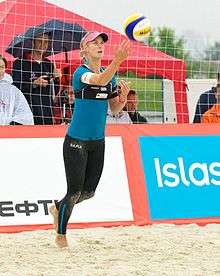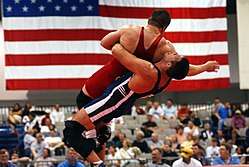Compression garment
Compression garments are pieces of clothing that fit tightly around the skin. In medical contexts, compression garments provide support for people who have to stand for long periods or have poor circulation. These come in varying degrees of compression, and higher degree compression sleeves, such as sleeves that provide compression of 20–30 mmHg or higher, typically require a doctor's prescription.[1] Compression garments worn on the legs can help prevent deep vein thrombosis and reduce swelling, especially while traveling.

In sports, form-fitting compression sportswear, usually made of spandex, is commonly worn by athletes and in exercise to prevent chafing and rashes.
Maternity wear
A bellyband, wrap, or abdominal binder is a compression garment which resembles a tubetop but worn over the abdomen of expectant mothers.[2] Bellybands are also commonly worn post child birth to help provide abdominal and back support thereby making it easier to perform day to day tasks, and to help mothers with their posture.
Compression stockings and socks
Compression stockings and socks is hosiery specifically designed to help prevent the occurrence of various medical disorders relating to blood circulation in the legs. They can also be used to halt the progression of these disorders.
Sportswear
_3.jpg)

Compression sportswear (shirts, shorts, sleeves, socks or underwear) is usually worn by athletes who wish to enhance performance or recovery speed. Garments are form-fitting garments often made from a spandex-type material.
One small study of compression shorts found no change in sprint time, but found some gait changes that might reduce injuries.[3] Another study of calf sleeves found no change in sprint times and gait; larger reviews have found no evidence that compression garments can improve athletic performance beyond the placebo effect.[4]
Through testing repeat-sprint and throwing performance in cricket players, one study found that there was a significant difference by way of higher mean skin temperature, lower 24-hour post exercise CK values and lower 24-hour post exercise ratings of muscle soreness when wearing compression garments. However, the study failed to find any significant difference in sprint performance, throwing performance, heart rate, or various blood tests.[5]
In materials testing, the compressive garment provided increased flexion and extension, which could help reduce hamstring injuries. They also reduced impact by 27% compared to American football pants alone.[6] Studies have shown that compressive garments can improve long term vertical jump height.[7]
Depending on the material used and the requirements of the sport, compression garments can be designed to keep athletes cool or warm. For example, speedskaters can wear compression bodysuits on the cold rink, while beach volleyball players can wear a similar-looking suit but its made out of a more breathable, lightweight blend. Both use moisture wicking materials like nylon and spandex in order to keep the garment lightweight. Additionally, speed skaters can use the aerodynamic nature of wearing a skintight suit to their advantage, while a beach volleyball player has the added benefit of SPF 50+ garments to keep them protected during sunny days.[8] The athletes pictured show the range of benefits that make compression garments popular in a wide range of sports and designs.
Other purported benefits of compression sportswear:
- Keeping the muscles warm to prevent muscle strain.[9]
- Wicking sweat away from the body to prevent chafing and rashes.[10]
- Helping relieve pain from muscle stiffness and soreness.[11]
 Wrestlers wear compressing, elastic clothing.
Wrestlers wear compressing, elastic clothing. - Reducing the time taken for muscles to repair themselves.[12]
- When the right amount of compression is used (will vary depending on body area, typically in the range of 10 to 25 mmHg), improving venous return and oxygenation to working muscles.[11]
- Stabilizing joints.
Shorts and tights

Compression shorts and tights are usually worn by athletes. They are form-fitting garments and when worn, cover the athlete's waist to mid or lower thigh, similar to cycling shorts. They are referred to as spats in Japan and safety shorts in South Korea.
Many are available with a cup pocket, a sewn-in pocket that can hold a protective cup. It is arguable that compression shorts do not keep cups in the proper position, tight to the body and not moving, as a jockstrap can. Some players wear the compression shorts over the traditional jockstrap.[13]
Compression shorts are also popular among female athletes, especially amongst those who wear skirts or kilts during games. In those situations, athletes wear compression shorts under the skirt so if they fall over and their skirts ride up, their underwear will not be exposed. This is seen particularly in women's lacrosse and field hockey (both being limited contact sports in which players often wear skirts). In this situation, compression shorts are colloquially identified as spandex shorts. Women also wear compression shorts in tennis, where, most recently, compression shorts have been produced with ball pockets for convenience.
Post-workout benefit
Compression garments have been shown to help athletes during the active recovery process. Research shows that following a high intensity treadmill workout, compression garments helped to decrease the heart rate and lactic acid buildup in athletes.[14] According to a study by Duffield R. and M. Portis, although there were few observed changes during their event, cricket players wearing compression garments showed fewer blood markers of muscle damage and reported less soreness during the 24-hour post-workout period.[15] Other studies have supported the idea that compression garments are effective in reducing post-workout declines in jump height, minimizing strength loss, decreasing swelling, and easing muscle soreness after competition.[16]
See also
- Rugby shorts
- Skin-tight garment
- Sports clothing
- Military anti-shock trousers
References
- "Seattle Cancer Care Alliance". seattlecca.org. 2016. Retrieved 2016-12-12.
- Curtis, Glade B.; et al. (2016), Your Pregnancy: Week by Week, 8th ed., Da Capo Press, p. 414.
- Doan BK, Kwon YH, Newton RU, et al. (Aug 2003). "Evaluation of a lower-body compression garment". J Sports Sci. 21 (8): 601–10. doi:10.1080/0264041031000101971. PMID 12875311.
- "Compression Clothes' Advantage Could be Placebo Effect".
- Duffield; Portus, M; Edge, J. (2007). "Comparison of three types of full-body compression garments on throwing and repeat-sprint performance in cricket players". British Journal of Sports Medicine. 41 (7): 409–14, discussion 414. doi:10.1136/bjsm.2006.033753. PMC 2465357. PMID 17341589.
- Doan; Kwon, YH; Newton, RU; Shim, J; Popper, EM; Rogers, RA; Bolt, LR; Robertson, M; Kraemer, WJ (2003). "Evaluation of a lower-body compression garment". Journal of Sports Sciences. 21 (8): 601–10. doi:10.1080/0264041031000101971. PMID 12875311.
- "Influence of Compression Garments on Vertical Jump Performan... : The Journal of Strength & Conditioning Research". LWW. Retrieved 2017-05-31.
- "The compression clothing phenomenon - Women's Health & Fitness". www.womenshealthandfitness.com.au. Retrieved 2017-05-30.
- "Benefits of Wearing Compression Shorts". @berkeleywellness. Retrieved 2017-05-15.
- "5 Reasons Why You Should Wear Compression Shorts". Prime Compression. Retrieved 2017-05-15.
- "The Compression Clothing Craze". Men's Journal. Retrieved 2017-05-15.
- Kraemer, WJ; Bush, JA; Wickham, RB; Denegar, CR; Gómez, AL; Gotshalk, LA; Duncan, ND; Volek, JS; et al. (2001). "Influence of compression therapy on symptoms following soft tissue injury from maximal eccentric exercise". The Journal of Orthopaedic and Sports Physical Therapy. 31 (6): 282–90. doi:10.2519/jospt.2001.31.6.282. PMID 11411623.
- "Where have all the jockstraps gone?". Slate Magazine (2005-07-22). 2005-07-22.
- Lovell, Dale I.; Mason, Dale G.; Delphinus, Elias M.; McLellan, Christopher P. (2011-12-01). "Do compression garments enhance the active recovery process after high-intensity running?". Journal of Strength and Conditioning Research. 25 (12): 3264–3268. CiteSeerX 10.1.1.671.5841. doi:10.1519/JSC.0b013e31821764f8. ISSN 1533-4287. PMID 22082795.
- Duffield, Rob; Portus, Marc (2007-07-01). "Comparison of three types of full-body compression garments on throwing and repeat-sprint performance in cricket players". British Journal of Sports Medicine. 41 (7): 409–414, discussion 414. doi:10.1136/bjsm.2006.033753. ISSN 1473-0480. PMC 2465357. PMID 17341589.
- "Is Compression Gear Really Effective?". ACTIVE.com. 2012-12-11. Retrieved 2017-05-30.